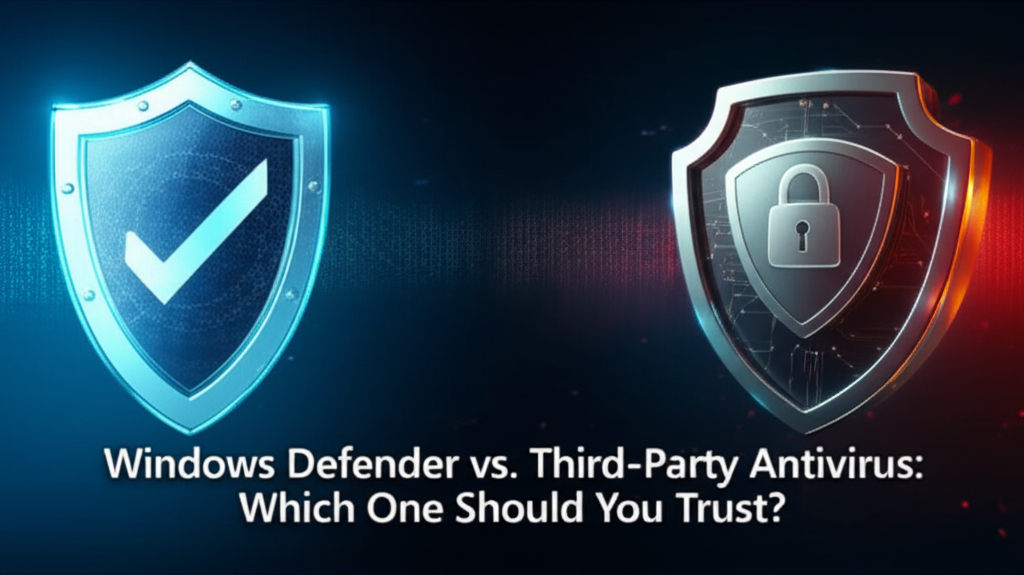Introduction
In today’s digital age, cybersecurity is more crucial than ever. With online threats becoming increasingly sophisticated, ensuring that your computer is protected from viruses, malware, and other forms of cyberattacks is fundamental. When it comes to guarding your Windows device, you have two primary choices: Windows Defender, which comes pre-installed with Windows 10 and 11, or a third-party antivirus solution.
But how do you know which one is right for you? This guide will help you understand the pros and cons of both options, troubleshoot common issues, and make informed decisions about your computer’s security.
Why This Matters
Choosing the right antivirus solution can mean the difference between a secure, smoothly running device and one that’s vulnerable to threats. This guide aims to arm you with knowledge about features, performance, and ease of use. Whether you are a novice user or someone looking to secure your system further, you’ll find useful tips and tricks to optimize your security setup.
Step-by-Step Guide to Choosing Your Antivirus Solution
1. Understanding Windows Defender
Windows Defender, now known as Microsoft Defender Antivirus, is an essential part of Windows operating systems. It runs scans automatically and provides real-time protection against malware and threats. Let’s explore its capabilities.
Features of Windows Defender:
- Real-Time Protection: Constantly scans files and downloads.
- Easy Integration: Built into Windows, meaning no installation is required.
- Scheduled Scans: Allows users to schedule scans at convenient times.
- Firewall: Comes with Windows Firewall to provide an additional layer of security.
Checking Windows Defender Status
-
Open Settings: Click on the Start menu, then select Settings (the gear icon).
-
Update & Security: Click on Update & Security.
-
Windows Security: Select Windows Security from the left sidebar.
-
Virus & Threat Protection: Click on Virus & threat protection.
- Check Protection Status: You can see if your device is protected.
2. Evaluating Third-Party Antivirus Solutions
While Windows Defender is robust, some users prefer third-party antivirus solutions for additional features and heightened security. Popular options include:
- Norton Antivirus
- McAfee
- Kaspersky
- Bitdefender
Pros and Cons of Third-Party Antivirus
Pros:
- Advanced Features: Extra tools like VPNs, password managers, or system optimizers.
- Enhanced Detection: Some third-party tools may offer better malware detection rates.
- User Interface: Often designed for more straightforward navigation.
Cons:
- Cost: Many are subscription-based.
- Resource Intensive: Can slow down your system due to additional features.
- Complexity: Some features may be overwhelming for beginner users.
3. Installation and Setup
If you decide to go with a third-party antivirus, here’s how to install and set it up.
Downloading Third-Party Antivirus:
-
Visit the Official Website: Ensure you only download from the official site to avoid malicious downloads.
- Example: www.norton.com
-
Purchase and Download: Follow the instructions for purchase; you should then be prompted to download the installer.
-
Run the Installer: Open the downloaded file to begin installation.
-
Follow Installation Prompts: Choose settings and agree to terms as prompted by the installer.
- Complete Setup: After installation, the antivirus may guide you through setup options, including enabling real-time protection.
4. Common Installation Issues
Error Messages: Sometimes, antivirus installations fail with error messages like "Installation Failed" or "Incompatible Software Detected."
Quick Fixes:
- Check System Requirements: Ensure your system meets the antivirus software’s minimum requirements.
-
Uninstall Conflicting Software: Remove any existing antivirus solutions before installing a new one. Use the Control Panel:
- Go to Control Panel > Programs > Programs and Features.
- Find the existing antivirus, right-click, and choose Uninstall.
- Restart Your Computer: A simple reboot can sometimes resolve installation issues.
5. Regular Maintenance and Scans
Both Windows Defender and third-party antivirus software require regular maintenance and scans.
Setting Up Automatic Scans in Windows Defender
-
Open Windows Security: Go back to the Windows Security settings as shown previously.
-
Virus & Threat Protection Settings: Scroll down and click on Manage settings.
- Scheduled Scans: Here, you can set up scheduled scans by selecting Scan history for any previous scan logs.
Setting Up Scans in Third-Party Antivirus
Most third-party antivirus programs offer options for scheduling scans.
- Open the antivirus application.
- Look for the Scheduled Scans option (usually found under Settings).
- Choose frequency (daily, weekly, etc.) and time, then save your settings.
6. Advanced Tweaks for Power Users
If you are more experienced, here are some advanced settings you might want to consider.
Power User Tip: Configuring Windows Defender
-
Add Exclusions: If you trust specific files or applications, you can add them to the exclusion list.
- Virus & Threat Protection: Open Windows Security.
- Manage Settings: Go to Manage settings underneath Virus & threat protection settings.
- Add or Remove Exclusions: Scroll down to Exclusions section and click Add or remove exclusions.
Configuring Third-Party Antivirus
-
Adjusting Sensitivity: Look into the sensitivity settings; some antivirus programs allow you to change how aggressively they scan for threats.
- Exclusions: Similar to Windows Defender, third-party solutions also allow you to whitelist files/folders.
7. Common Errors and Troubleshooting
As users navigate antivirus software, they may encounter some common issues.
Common Errors:
-
System Slowing Down: Your computer might run slowly due to the antivirus scanning.
- Solution: Schedule scans for off-peak hours or adjust scanning settings.
-
Frequent Notifications: You receive excess notifications from the software.
- Solution: Adjust notification settings in the software preferences.
- Incompatibility Errors: Your third-party antivirus conflicts with Windows Defender.
- Solution: Make sure to turn off Windows Defender if you’ve installed a third-party solution (or vice versa).
8. Summary Checklist for Quick Reference
- Protection Status: Check regularly in Windows Security for protection status.
- Scheduled Scans: Set up scheduled scans for both Windows Defender and third-party antivirus.
- Update Software: Ensure Windows and antivirus software are always up to date.
- Review Quarantine Lists: Regularly check and manage quarantined items.
- Check Performance: Monitor your system’s performance and adjust settings accordingly.
Conclusion
Whether you choose Windows Defender or a third-party antivirus solution, your priority should be maintaining a secure and well-performing device. For beginners, Windows Defender offers a native, straightforward solution without the need for installation or cost. For those seeking additional features and enhanced protection, a third-party variant could serve them better—with the caveat that they can be more complex and require maintenance.
Final Advice
Stay informed about cybersecurity trends, educate yourself continuously on best practices, and always have a backup of important files. Your digital safety is in your hands!

